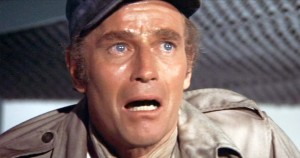 As with most of my blog posts, this one has grown out of many intertwined roots. The first was the featuring of cannibalism as a theme in the opening episodes of The Walking Dead’s fifth season. The second was my reading, at the same time, of Robert Wood’s well-researched volume Destination: Moonbase Alpha, a re-visitation of the making of one of my all-time favorite SF series, Space: 1999. (A show which many in the SF community hold in utter contempt. 1999 fans long ago learned to stop caring in the slightest.) The final contributing factor was my participation at PhilCon, only days ago as I began writing this, in a panel discussion about William H. Patterson’s authorized biography of the Dean of American SF, Robert A. Heinlein: In Dialogue with His Century. This was a well-attended discussion moderated by author Michael Swanwick.
As with most of my blog posts, this one has grown out of many intertwined roots. The first was the featuring of cannibalism as a theme in the opening episodes of The Walking Dead’s fifth season. The second was my reading, at the same time, of Robert Wood’s well-researched volume Destination: Moonbase Alpha, a re-visitation of the making of one of my all-time favorite SF series, Space: 1999. (A show which many in the SF community hold in utter contempt. 1999 fans long ago learned to stop caring in the slightest.) The final contributing factor was my participation at PhilCon, only days ago as I began writing this, in a panel discussion about William H. Patterson’s authorized biography of the Dean of American SF, Robert A. Heinlein: In Dialogue with His Century. This was a well-attended discussion moderated by author Michael Swanwick.
PhilCon was before Thanksgiving, and The Walking Dead has already reached its mid-season finale for this year. As you can tell, this discussion has been brewing for a while.
Why is cannibalism, perhaps the ultimate demonstration of a lack of civilization, of an abandonment of any pretense that a human is a moral animal, elevated above other animals, so prevalent in SF? In horror, sure, we’d expect to see it. Horror stories are meant to deliver us away from our intellect, from our veneer of confidence and deportment, to scare our inner child. Thus horror stories allow us to explore the boundaries of our faith in our own superiority, our own sense of control. As Dylan McDermott’s character observes in an episode of American Horror Story, “All art and myths are just creations to give us a sense of control over things we’re scared of.” Horror, simply, challenges us and reassures us at the same time.
But SF? SF is supposed to look toward the future and, whether utopian or dystopian, whether positive or negative in its evaluation of human ingenuity, it’s supposed to point out to us how we can be better. And yet so many examples have been brought to my attention, in the span of a few short weeks, of the intellectual genre of SF dabbling in the horrific theme of people eating people.
Now, to be fair, The Walking Dead is as much a horror story as a speculative fiction story. It’s about zombies, after all. But its presentation of the characters and how they deal with their situations is so realistic, so carefully thought out, so plausible, that I feel it ranks with the best of SF. Space: 1999 has been dubbed “gothic” by author and fellow fan Andrew E.C. Gaska, who’s written some of the most recent adventures of the Alphans. It definitely sits outside the SF mainstream in a lot of ways. Perhaps that’s why it’s resented. So maybe it’s no surprise that these two series take on a topic more appropriate to horror. But what about the SF classic Stranger in a Strange Land, by the aforementioned Heinlein, or Farnham’s Freehold, less well-known, certainly less beloved, but by the same ingenious author?
Let’s look at how each story handled cannibalism:
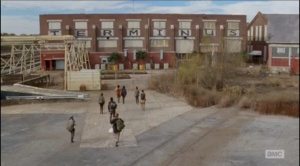 The Walking Dead, of course, played it for shock value. That’s not a criticism, for once. I usually hate shock in stories, but this is an example of how it’s appropriately used. Our heroes, after wandering the landscape of the zombie apocalypse, homeless and barely scraping by for a few weeks, find signs which advertise a place called Terminus as a sanctuary, promising that there really is a place that’s safe, a place where they can have a good life. “Terminus” turns out to be the end of the line, literally. It’s a railroad terminus where a group of people have established a walled encampment. The refugees enter, are asked to please turn in their weapons, because this is a peaceful place, and are then invited to a barbecue. Guess what type of meat is being served?
The Walking Dead, of course, played it for shock value. That’s not a criticism, for once. I usually hate shock in stories, but this is an example of how it’s appropriately used. Our heroes, after wandering the landscape of the zombie apocalypse, homeless and barely scraping by for a few weeks, find signs which advertise a place called Terminus as a sanctuary, promising that there really is a place that’s safe, a place where they can have a good life. “Terminus” turns out to be the end of the line, literally. It’s a railroad terminus where a group of people have established a walled encampment. The refugees enter, are asked to please turn in their weapons, because this is a peaceful place, and are then invited to a barbecue. Guess what type of meat is being served?
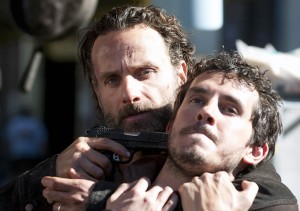 When former Sheriff Rick Grimes, the principal protagonist of the series, spots a familiar pocket watch in the hands of one of their hosts, the jig is up. Ricks’s missing people, and the residents of Terminus somehow have the possessions of those missing people. His angry questions lead to a gun battle, which leads to Rick and company being imprisoned in a boxcar, where they will wait to be slaughtered and used as rations. This short-circuited their hosts’ plan, which was to feed them human flesh, then take them aside, tell them what they ate, and ask, “How ya feel about that?” Anyone who was okay with it would be allowed to stay on with cafeteria privileges. Anyone who wasn’t okay with it would also be bound for the barbecue line, but would be arriving on a platter.
When former Sheriff Rick Grimes, the principal protagonist of the series, spots a familiar pocket watch in the hands of one of their hosts, the jig is up. Ricks’s missing people, and the residents of Terminus somehow have the possessions of those missing people. His angry questions lead to a gun battle, which leads to Rick and company being imprisoned in a boxcar, where they will wait to be slaughtered and used as rations. This short-circuited their hosts’ plan, which was to feed them human flesh, then take them aside, tell them what they ate, and ask, “How ya feel about that?” Anyone who was okay with it would be allowed to stay on with cafeteria privileges. Anyone who wasn’t okay with it would also be bound for the barbecue line, but would be arriving on a platter.
Since the show didn’t change its name to “Those Fine Young Cannibals,” you can imagine that Rick and company escaped this ugly situation without too many tooth marks. The big question was not, “Would our heroes make it?” it was “What would our heroes do about the cannibal colony?” Rick’s initial solution was simple: “Kill them all.” But his team didn’t kill them all. Not at first. They fought their way out, killing where necessary, leaving the Terminus compound in such a state that it would no longer be listed in post-apocalyptic travel guides as even a one-star restaurant. Rick wanted to regroup, go back and finish the killing. He was talked out of it, then had to do it anyway as the survivors from Terminus continued to hunt, eat and threaten his people.
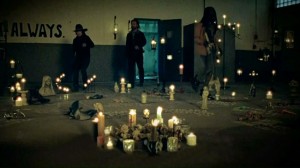 In flashbacks, we learn that Terminus was once a non-cannibal safe haven, which offered shelter to all. Then a pack of outsiders tried to take over, and, in the attempt, raped and killed quite a number of once-peaceful people who tried to help them. This caused Terminus Mary (Denise Crosby) and her family to declare, “Never again. Never trust. We first, always.” They decided to eat outsiders, not welcome them.
In flashbacks, we learn that Terminus was once a non-cannibal safe haven, which offered shelter to all. Then a pack of outsiders tried to take over, and, in the attempt, raped and killed quite a number of once-peaceful people who tried to help them. This caused Terminus Mary (Denise Crosby) and her family to declare, “Never again. Never trust. We first, always.” They decided to eat outsiders, not welcome them.
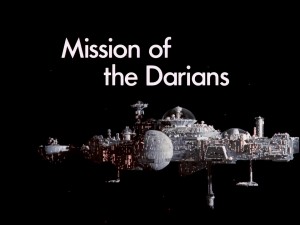 “Mission of the Darians,” a Space:1999 episode written by Johnny Byrne, was far more circumspect in its handling of cannibalism. It first aired in October, 1975, after all. At that time, censorship was far tighter world-wide, and some topics just “weren’t done.” So, where The Walking Dead could show what’s recognized now as the most violent scene ever on non-premium television — Rick and a half dozen others getting bent over a trough to have their throats slit so they could bleed out in preparation for, well, preparation–Space:1999 could only show living bodies being disintegrated and broken down into their basic proteins, or harvested for organ transplants.
“Mission of the Darians,” a Space:1999 episode written by Johnny Byrne, was far more circumspect in its handling of cannibalism. It first aired in October, 1975, after all. At that time, censorship was far tighter world-wide, and some topics just “weren’t done.” So, where The Walking Dead could show what’s recognized now as the most violent scene ever on non-premium television — Rick and a half dozen others getting bent over a trough to have their throats slit so they could bleed out in preparation for, well, preparation–Space:1999 could only show living bodies being disintegrated and broken down into their basic proteins, or harvested for organ transplants.
In this case the Daria, a 100-square-mile alien spaceship, peopled by humanoids, has suffered a nuclear disaster and is wandering the cosmos, crippled. The disaster was 900 years ago, and about a dozen Darians are living in splendor in an isolated section of the ship, while potentially hundreds of others live in the wilds in the irradiated disaster zone. The dozen “nobles” are actual survivors of the disaster. They’ve prolonged their lives indefinitely so they can protect the Darian gene bank, containing the material to reconstruct their race and civilization on a new world. All the others around them are descendants, mutated, feral, taught to worship the dozen survivors as gods. They are used, as mentioned, to feed the few and prolong their lives via organ transplant.
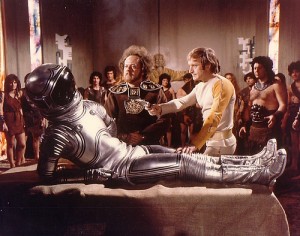 Commander John Koenig and his team discover what’s going on, after a few of them are invited to become a part of Daria, while a few others are killed and/or shipped off to be unwilling organ donors. The Darian “nobles” are at first irresolute: in the name of racial survival, everything they’ve done is okay. Individual lives don’t matter, only the race does.
Commander John Koenig and his team discover what’s going on, after a few of them are invited to become a part of Daria, while a few others are killed and/or shipped off to be unwilling organ donors. The Darian “nobles” are at first irresolute: in the name of racial survival, everything they’ve done is okay. Individual lives don’t matter, only the race does.
Koenig and company kill no one on purpose, but they do leave the Darians forced to integrate their society and stop using each other. A key question is asked as the episode closes: Koenig’s Chief Pilot, Captain Alan Carter, asks him, “If the same thing happened on Alpha, would you have chosen differently?” (Moonbase Alpha is the complex Koenig commands, on Earth’s Moon, which has been blown out of orbit and, like Daria, wanders the cosmos, homeless.) Koenig’s reply is “Remind me to tell you sometime.”
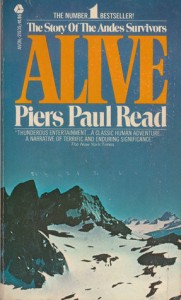 While the story is circumspect, writer Johnny Byrne was not, citing the airline crash in the Andes which was the subject of the best-selling book Alive! as the inspiration for this story.
While the story is circumspect, writer Johnny Byrne was not, citing the airline crash in the Andes which was the subject of the best-selling book Alive! as the inspiration for this story.
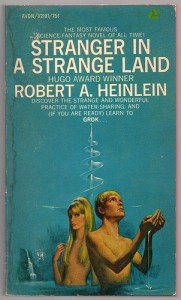 Stranger in a Strange Land is one of Robert A Heinlein’s four Hugo-winning novels. It’s about Valentine Michael Smith, born in space to human parents, and the sole survivor of the first expedition to Mars. By the time he’s found by a rescue expedition, he’s an adult, and has been raised by Martians. Heinlein was a (pardon me) real SF writer. His aliens weren’t just humans with different colored skin or little air vents under their eye sockets, or really stupid hairstyles. His aliens were weird. His Martians were like nothing most people would ever imagine. For one thing, when they died, they didn’t go away. They became “old ones.” Not corporeal, but not gone, either. For another thing, again when they died, part of the funeral process was for friends and family to eat the remains as a tribute. Early on, when given a meal in an Earth hospital, Mike asks, “Who is this?” His Doctor assumes he just isn’t current on English grammar. Mwa-hah-hah! When Mike finally dies, his friends eat him. In soup. There is no shock, no horror. Just a practice that makes a lot of us uncomfortable being treated as perfectly normal. Important to consider that not once does any character suggest that it would be acceptable on Mars to kill someone and eat them. Indeed, context suggests you would not eat someone you thought so little of that you would kill them.
Stranger in a Strange Land is one of Robert A Heinlein’s four Hugo-winning novels. It’s about Valentine Michael Smith, born in space to human parents, and the sole survivor of the first expedition to Mars. By the time he’s found by a rescue expedition, he’s an adult, and has been raised by Martians. Heinlein was a (pardon me) real SF writer. His aliens weren’t just humans with different colored skin or little air vents under their eye sockets, or really stupid hairstyles. His aliens were weird. His Martians were like nothing most people would ever imagine. For one thing, when they died, they didn’t go away. They became “old ones.” Not corporeal, but not gone, either. For another thing, again when they died, part of the funeral process was for friends and family to eat the remains as a tribute. Early on, when given a meal in an Earth hospital, Mike asks, “Who is this?” His Doctor assumes he just isn’t current on English grammar. Mwa-hah-hah! When Mike finally dies, his friends eat him. In soup. There is no shock, no horror. Just a practice that makes a lot of us uncomfortable being treated as perfectly normal. Important to consider that not once does any character suggest that it would be acceptable on Mars to kill someone and eat them. Indeed, context suggests you would not eat someone you thought so little of that you would kill them.
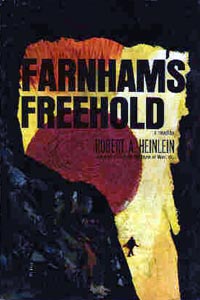 Finally, bringing the shock and awe back, the later Heinlein novel Farnham’s Freehold describes a middle-class family from the 1960s who survive a nuclear war, only to find that the Bomb has catapulted their little bomb shelter through time, and they’re now living in an America ruled by survivors of the nuclear holocaust who emigrated from Africa. These survivors have built a slave state in which those with black skin are the owners, and those with white skin are the slaves. Hugh Farnham, head of the (pun intended) nuclear family, becomes a trusted “senior” slave, and thus discovers the hidden horror (as if slavery weren’t enough!): the white slaves are also killed and eaten by their masters.
Finally, bringing the shock and awe back, the later Heinlein novel Farnham’s Freehold describes a middle-class family from the 1960s who survive a nuclear war, only to find that the Bomb has catapulted their little bomb shelter through time, and they’re now living in an America ruled by survivors of the nuclear holocaust who emigrated from Africa. These survivors have built a slave state in which those with black skin are the owners, and those with white skin are the slaves. Hugh Farnham, head of the (pun intended) nuclear family, becomes a trusted “senior” slave, and thus discovers the hidden horror (as if slavery weren’t enough!): the white slaves are also killed and eaten by their masters.
Heinlein deplored racism, but this story got him branded a racist. His point was to turn the tables for white readers — to ask “How would you like the treatment your ancestors gave African slaves?” Of course, American whites didn’t eat African slaves. That was a metaphor intended to say that whites were still (in the Sixties) “devouring” black Americans by not truly allowing them to be equals, and by using them as an under-privileged workforce. The metaphor fell flat, because it looked to some like Heinlein was saying that Africans, left to their own devices, would become cannibals. It’s unfortunate because, at least in my opinion, Heinlein was one of the first and loudest voices in SF against racism.
Wow. Lotsa words of introduction there. And I’ve only introduced the topic. Next week I’ll discuss some common themes, and dig into what theses stories, old and new, were saying when they introduced this disturbing, taboo, subject. Until then, sit back, relax, and, hey you know, salad is a legitimate food choice…

The only other examples I can think of are Piers Anthony’s “Rings of Ice” where it was not really a plot point merely something else the survivors had to do to live, and “Dune” where no water was wasted, not even from dead bodies. In both of those, though, no one was killed for the purpose of consumption.